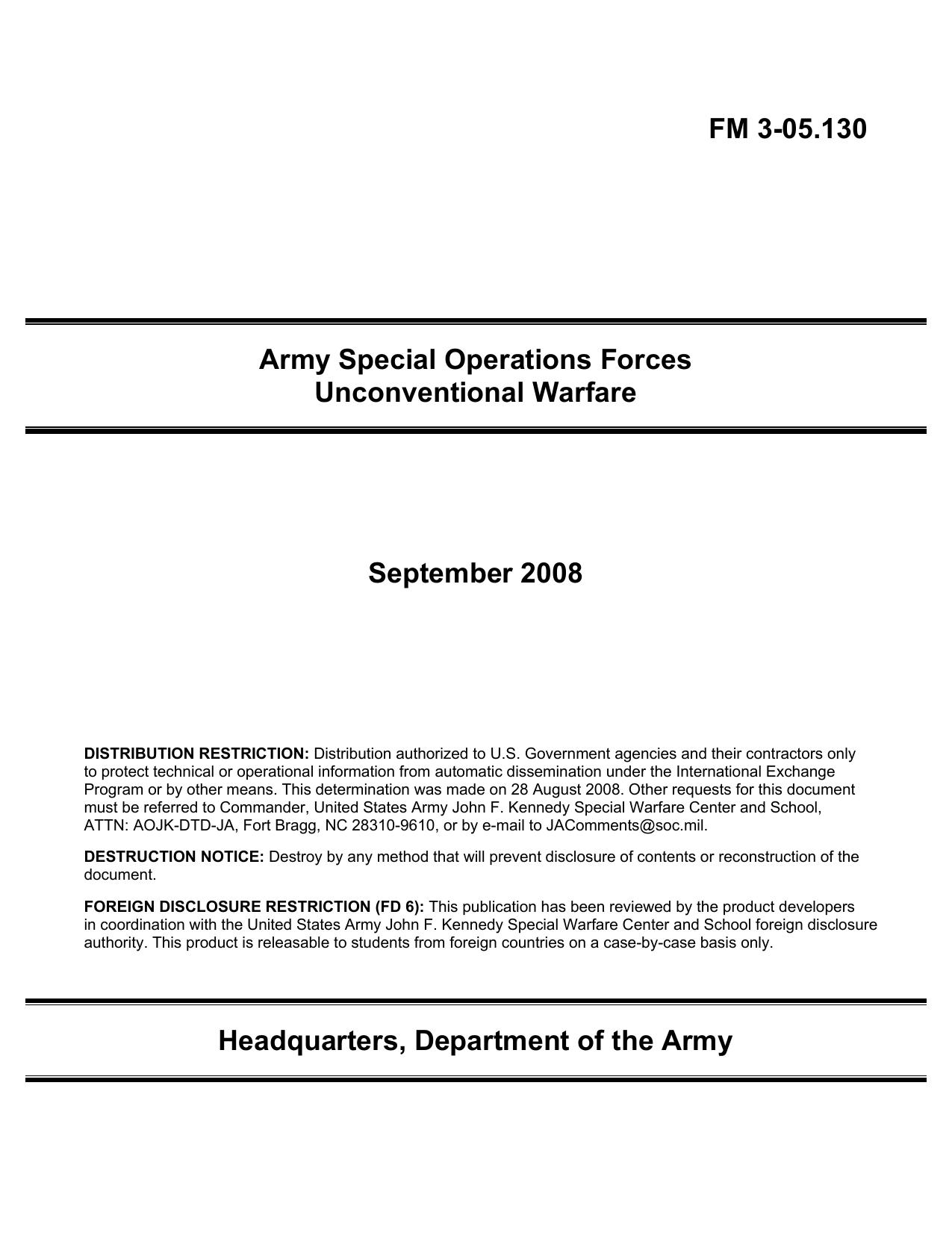Army Special Operations Forces Unconventional Warfare by FM 3-05.130

Author:FM 3-05.130
Language: eng
Format: mobi, pdf
Published: 0101-01-01T00:00:00+00:00
A-14
FM 3-05.130
30 September 2008
Appendix B
The Informational Instrument of National Power
INTERNATIONAL INFORMATION ENVIRONMENT
B-1. The information environment is the total of individuals, organizations, and systems that collect, process, disseminate, or act on information. The actors include leaders, decision makers, individuals, and organizations. Resources include the materials and systems employed to collect, analyze, apply, or disseminate information. The information environment is where humans and automated systems observe, orient, decide, and act upon information, and is therefore the principal environment of decision making.
Even though the information environment is considered distinct, it resides within each of the four domains of air, land, sea, and space.
B-2. The information environment is made up of three interrelated dimensions (Figure B-1, page B-2): z
The physical dimension. The physical dimension is made up of the C2 systems and supporting infrastructures that enable individuals and organizations to conduct operations across the four domains. It is also the dimension where physical platforms and the communications networks that connect them reside, which includes the means of transmission, infrastructure, technologies, groups, and populations. Comparatively, the elements of this dimension are the easiest to measure, and consequently, combat power has traditionally been measured primarily in this dimension.
z
The informational dimension. The informational dimension is where information is collected, processed, stored, disseminated, displayed, and protected. It is the dimension where the C2 of modern military forces is communicated, and where commander’s intent is conveyed. It consists of the content and flow of information. Consequently, it must be protected.
z
The cognitive dimension. The cognitive dimension encompasses the mind of the decision maker and the TA. People think, perceive, visualize, and decide in this dimension. It is the most important of the three dimensions. A commander’s orders, training, and other personal
motivations affect this dimension. Battles and campaigns can be lost in the cognitive dimension.
Factors such as leadership, morale, unit cohesion, emotion, state of mind, level of training, experience, situational awareness, as well as public opinion, perceptions, media, public information, and rumors influence this dimension.
B-3. Advancements in technology have enabled information to be collected, processed, stored, disseminated, displayed, and protected outside the cognitive process in quantities and at speeds that were previously incomprehensible. While technology makes great quantities of information available to audiences worldwide, perception-affecting factors provide the context that individuals use to translate data into information and knowledge.
B-4. There are criteria that define the quality of information relative to its purpose. The varying purposes of information require different applications of these criteria to qualify it as valuable. In addition, each decision relies on a different weighting of the information quality criteria to make the best decision. The finite amount of time and resources available to obtain information is a consideration. Whether decisions are made cognitively or preprogrammed in automated systems, the limited time and resources to improve the quality of available information leaves decision making subject to manipulation. In addition, there are real costs associated with obtaining quality information—that is, information well-suited to its purpose— such as those to acquire, process, store, transport, and distribute information. The overall impact of
Download
Army Special Operations Forces Unconventional Warfare by FM 3-05.130.pdf
This site does not store any files on its server. We only index and link to content provided by other sites. Please contact the content providers to delete copyright contents if any and email us, we'll remove relevant links or contents immediately.
| Africa | Americas |
| Arctic & Antarctica | Asia |
| Australia & Oceania | Europe |
| Middle East | Russia |
| United States | World |
| Ancient Civilizations | Military |
| Historical Study & Educational Resources |
The Radium Girls by Kate Moore(11616)
100 Deadly Skills by Clint Emerson(4684)
The Templars by Dan Jones(4556)
Rise and Kill First by Ronen Bergman(4542)
The Doomsday Machine by Daniel Ellsberg(4241)
The Rape of Nanking by Iris Chang(4019)
Killing England by Bill O'Reilly(3896)
Hitler in Los Angeles by Steven J. Ross(3796)
Stalin by Stephen Kotkin(3722)
12 Strong by Doug Stanton(3418)
Hitler's Monsters by Eric Kurlander(3161)
Blood and Sand by Alex Von Tunzelmann(3055)
Darkest Hour by Anthony McCarten(3017)
The Code Book by Simon Singh(2854)
The Art of War Visualized by Jessica Hagy(2836)
Hitler's Flying Saucers: A Guide to German Flying Discs of the Second World War by Stevens Henry(2621)
Babylon's Ark by Lawrence Anthony(2427)
The Second World Wars by Victor Davis Hanson(2419)
Tobruk by Peter Fitzsimons(2373)
